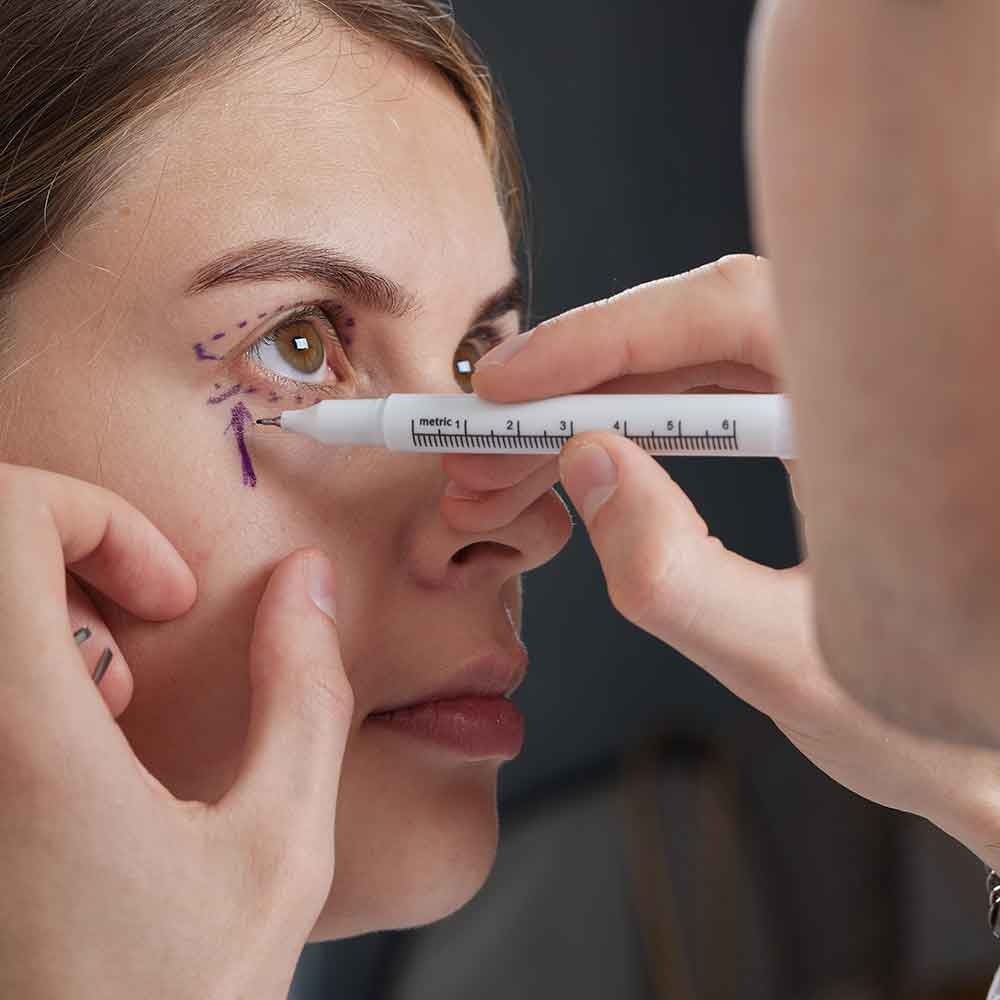Upper vs. Lower Blepharoplasty: Understanding the Differences

Blepharoplasty, or eyelid surgery, addresses common concerns around the eyes that contribute to a tired or aged appearance. You may require upper blepharoplasty, lower blepharoplasty, or both, depending on your concerns. Understanding the differences between these procedures can help you make an informed decision.
Upper Blepharoplasty
Upper blepharoplasty targets issues in the upper eyelids, such
Trusted Source
Blepharoplasty
Stanford Medicine
Go to Source
as
:
- Excess skin: Sagging or drooping skin that can create a crepey or hooded appearance.
- Fat bulges: Puffy areas along the upper eyelid crease.
- Ptosis: A condition where the eyelid muscle weakens, causing the upper lid to droop significantly.
Ptosis correction may be included in an upper blepharoplasty if the eyelid droop is caused by muscle laxity rather than excess skin alone. The procedure involves tightening or repairing the muscle to improve eyelid function and create a more alert appearance. Incisions are hidden within the natural crease, resulting in subtle scarring.
Lower Blepharoplasty
Lower blepharoplasty addresses the area beneath the eyes, including:
- Under-eye bags: Puffiness caused by fat pads protruding
Trusted Source Bags under the eyes Mayo Clinic Go to Source forward .
- Dark circles: Shadows created by fat displacement or volume loss.
- Skin laxity: Wrinkles or sagging beneath the lower lashes.
- Festoons and malar edema: Swelling or prominent folds on the cheekbone or lower eyelid, often due to fluid
Trusted Source Malar Mounds and Festoons: Review of Current Management Aesthetic Surgery Journal Go to Source retention , dermal
Trusted Source Avoiding Malar Edema During Midface/Cheek Augmentation with Dermal Fillers Journal of Clinical and Aesthetic Dermatology Go to Source fillers , skin laxity, or aging changes.
Traditionally, lower blepharoplasty involved removing fat from the lower eyelids to reduce puffiness. However, this often led to a hollowed look, accelerating the signs of aging. Today, fat repositioning is the preferred approach. Instead of discarding fat, the surgeon redistributes it from areas of excess to areas with volume loss, creating a smoother, more balanced contour.
Key aspects of lower blepharoplasty fat repositioning include:
- Reducing under-eye bags by shifting fat rather than removing it.
- Filling hollows, such as the tear trough, to soften depressions under the eyes.
- Preserving natural volume to avoid a gaunt or aged appearance over time.
Festoons and malar edema require careful evaluation as their treatment can vary. In some cases, they may be addressed during lower blepharoplasty by tightening the skin and underlying structures, or adjunctive facial lifting procedures.
Key Differences
| Feature | Upper Blepharoplasty | Lower Blepharoplasty |
Focus Area | Upper eyelids | Under-eye area and cheeks |
Common Concerns | Excess skin, fat bulges, ptosis | Bags, dark circles, festoons, malar edema |
Incision Location | Eyelid crease | Lash line or inside the eyelid |
Combination Blepharoplasty & Beyond
Combining the procedures can offer optimal results for patients with concerns affecting upper and lower eyelids. For a more comprehensive facial rejuvenation, combining upper and lower blepharoplasty with procedures like laser skin resurfacing, a brow lift, or a mid-face cheek lift can address multiple areas of concern and achieve balanced, harmonious results.
- Brow Lift: For patients with a sagging brow or deep forehead lines, a brow lift complements upper blepharoplasty by elevating the brow and smoothing the upper face. This creates a more refreshed, alert appearance and prevents the brow from crowding the upper eyelids.
- Mid-Face Cheek Lift: When volume loss or sagging in the mid-face contributes to hollowing or under-eye bags, a cheek lift enhances lower blepharoplasty by elevating the cheek tissues. This smooths the transition between the lower eyelid and cheek, restoring youthful contours and reducing the appearance of tiredness.
Combining these procedures allows the surgeon to treat interconnected areas of the face, creating natural, cohesive results. During a consultation, your surgeon will evaluate your concerns and recommend a tailored plan to achieve your goals.
Schedule a Consultation
Contact us to schedule a consultation with board-certified plastic surgeon Dr. Samuel Sohn, who is experienced in upper and lower eyelid lift procedures. Whether you want to address cosmetic concerns like eye bags and dark circles or functional issues like ptosis, a tailored surgical plan can help achieve a refreshed, natural look.
Sources
1 Stanford Medicine. Blepharoplasty. https://med.stanford.edu/cosmeticsurgery/aestheticservices/face/blepharoplasty.html#. Accessed November 27, 2024.
2 Mayo Clinic. Bags under the eyes. https://www.mayoclinic.org/diseases-conditions/bags-under-eyes/symptoms-causes/syc-20369927#. Accessed November 27, 2024.
3 Aesthetic Surgery Journal. Malar Mounds and Festoons: Review of Current Management. https://pubmed.ncbi.nlm.nih.gov/24431347/. Accessed November 27, 2024.
4 Journal of Clinical and Aesthetic Dermatology. Avoiding Malar Edema During Midface/Cheek Augmentation with Dermal Fillers. https://pmc.ncbi.nlm.nih.gov/articles/PMC3244361/. Accessed November 27, 2024.

